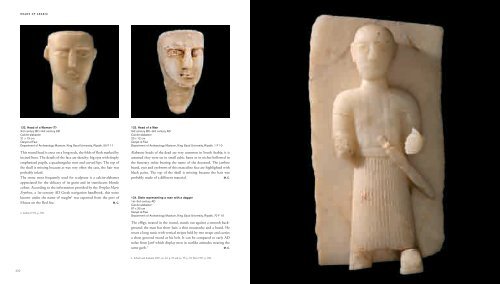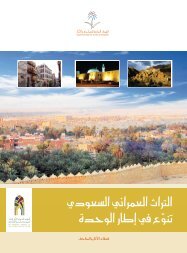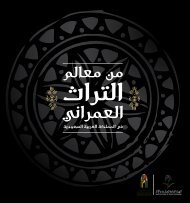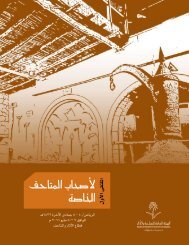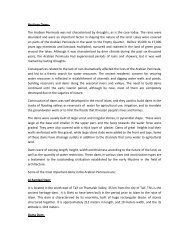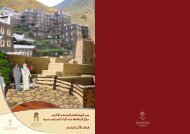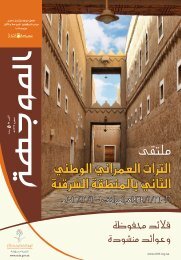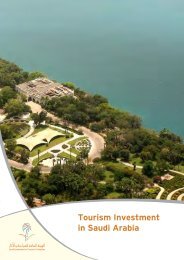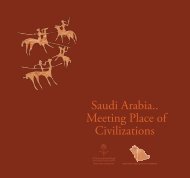- Page 1 and 2:
00 Arabie Saoudiens_p001-033_US.qxd
- Page 3 and 4:
00 Arabie Saoudiens_p001-033_US.qxd
- Page 5 and 6:
00 Arabie Saoudiens_p001-033_US.qxd
- Page 7 and 8:
00 Arabie Saoudiens_p001-033_US.qxd
- Page 9 and 10:
00 Arabie Saoudiens_p001-033_US.qxd
- Page 11 and 12:
00 Arabie Saoudiens_p001-033_US.qxd
- Page 13 and 14:
00 Arabie Saoudiens_p001-033_US.qxd
- Page 15 and 16:
00 Arabie Saoudiens_p001-033_US.qxd
- Page 17 and 18:
00 Arabie Saoudiens_p001-033_US.qxd
- Page 19 and 20:
01 Arabie_US_p034-043_BAT.qxd 23/06
- Page 21 and 22:
01 Arabie_US_p034-043_BAT.qxd 23/06
- Page 23 and 24:
02 Arabie US p044-053_BAT.qxd 23/06
- Page 25 and 26:
02 Arabie US p044-053_BAT.qxd 23/06
- Page 27 and 28:
02 Arabie US p044-053_BAT.qxd 23/06
- Page 29 and 30:
02bis (08) Arabie US p54-69_BAT.qxd
- Page 31 and 32:
02bis (08) Arabie US p54-69_BAT.qxd
- Page 33 and 34:
02bis (08) Arabie US p54-69_BAT.qxd
- Page 35 and 36:
02bis (08) Arabie US p54-69_BAT.qxd
- Page 37 and 38:
03 Arabie US p070-079_BAT.qxd 23/06
- Page 39 and 40:
03 Arabie US p070-079_BAT.qxd 23/06
- Page 41 and 42:
04 Arabie US_p080-99_BAT.qxd 23/06/
- Page 43 and 44:
04 Arabie US_p080-99_BAT.qxd 23/06/
- Page 45 and 46:
04 Arabie US_p080-99_BAT.qxd 23/06/
- Page 47 and 48:
04 Arabie US_p080-99_BAT.qxd 23/06/
- Page 49 and 50:
04 Arabie US_p080-99_BAT.qxd 23/06/
- Page 51 and 52:
05 Arabie US p100-109_CM_BAT.qxd 23
- Page 53 and 54:
05 Arabie US p100-109_CM_BAT.qxd 23
- Page 55 and 56:
05 Arabie US p100-109_CM_BAT.qxd 23
- Page 57 and 58:
06 Arabie US p110-117_BAT.qxd 23/06
- Page 59 and 60:
06 Arabie US p110-117_BAT.qxd 23/06
- Page 61 and 62:
07 Arabie US p118-131_BAT.qxd 23/06
- Page 63 and 64:
07 Arabie US p118-131_BAT.qxd 23/06
- Page 65 and 66:
07 Arabie US p118-131_BAT.qxd 23/06
- Page 67 and 68:
08bis Arabie US p132-135.qxd 23/06/
- Page 69 and 70:
09 Arabie US p136-157_CM_BAT.qxd 23
- Page 71 and 72:
09 Arabie US p136-157_CM_BAT.qxd 23
- Page 73 and 74:
09 Arabie US p136-157_CM_BAT.qxd 23
- Page 75 and 76:
09 Arabie US p136-157_CM_BAT.qxd 23
- Page 77 and 78:
09 Arabie US p136-157_CM_BAT.qxd 23
- Page 79 and 80:
09 Arabie US p136-157_CM_BAT.qxd 23
- Page 81 and 82:
10 Arabie US_p158-165_BAT.qxd 23/06
- Page 83 and 84:
10 Arabie US_p158-165_BAT.qxd 23/06
- Page 85 and 86:
11 Arabie US p166-169_CM_BAT.qxd 23
- Page 87 and 88:
12 Arabie US p170-207_CM_BAT.qxd 23
- Page 89 and 90:
12 Arabie US p170-207_CM_BAT.qxd 23
- Page 91 and 92:
12 Arabie US p170-207_CM_BAT.qxd 23
- Page 93 and 94:
12 Arabie US p170-207_CM_BAT.qxd 23
- Page 95 and 96:
12 Arabie US p170-207_CM_BAT.qxd 23
- Page 97 and 98:
12 Arabie US p170-207_CM_BAT.qxd 23
- Page 99 and 100:
12 Arabie US p170-207_CM_BAT.qxd 23
- Page 101 and 102:
12 Arabie US p170-207_CM_BAT.qxd 23
- Page 103 and 104:
12 Arabie US p170-207_CM_BAT.qxd 23
- Page 105 and 106:
13 Arabie US p208-217_BAT.qxd 23/06
- Page 107 and 108:
13 Arabie US p208-217_BAT.qxd 23/06
- Page 109 and 110:
13 Arabie US p208-217_BAT.qxd 23/06
- Page 111 and 112: 14 Arabie US_p218-261.qxd 23/06/10
- Page 113 and 114: 14 Arabie US_p218-261.qxd 23/06/10
- Page 115 and 116: 14 Arabie US_p218-261.qxd 23/06/10
- Page 117 and 118: 14 Arabie US_p218-261.qxd 23/06/10
- Page 119 and 120: 14 Arabie US_p218-261.qxd 23/06/10
- Page 121 and 122: 14 Arabie US_p218-261.qxd 23/06/10
- Page 123 and 124: 14 Arabie US_p218-261.qxd 23/06/10
- Page 125 and 126: 14 Arabie US_p218-261.qxd 23/06/10
- Page 127 and 128: 14 Arabie US_p218-261.qxd 23/06/10
- Page 129 and 130: 14 Arabie US_p218-261.qxd 23/06/10
- Page 131 and 132: 14 Arabie US_p218-261.qxd 23/06/10
- Page 133 and 134: 15 Arabie US_p262-269_BAT.qxd 23/06
- Page 135 and 136: 15 Arabie US_p262-269_BAT.qxd 23/06
- Page 137 and 138: 16 Arabie US p270-285_BAT.qxd 23/06
- Page 139 and 140: 16 Arabie US p270-285_BAT.qxd 23/06
- Page 141 and 142: 16 Arabie US p270-285_BAT.qxd 23/06
- Page 143 and 144: 16 Arabie US p270-285_BAT.qxd 23/06
- Page 145 and 146: 17 Arabie US p286-307.qxd 23/06/10
- Page 147 and 148: 17 Arabie US p286-307.qxd 23/06/10
- Page 149 and 150: 17 Arabie US p286-307.qxd 23/06/10
- Page 151 and 152: 17 Arabie US p286-307.qxd 23/06/10
- Page 153 and 154: 17 Arabie US p286-307.qxd 23/06/10
- Page 155 and 156: 18 Arabie US p308-317_BAT.qxd 23/06
- Page 157 and 158: 18 Arabie US p308-317_BAT.qxd 23/06
- Page 159 and 160: 18 Arabie US p308-317_BAT.qxd 23/06
- Page 161: 18bis Arabie US p318-363.qxd 23/06/
- Page 165 and 166: 18bis Arabie US p318-363.qxd 23/06/
- Page 167 and 168: 18bis Arabie US p318-363.qxd 23/06/
- Page 169 and 170: 18bis Arabie US p318-363.qxd 23/06/
- Page 171 and 172: 18bis Arabie US p318-363.qxd 23/06/
- Page 173 and 174: 18bis Arabie US p318-363.qxd 23/06/
- Page 175 and 176: 18bis Arabie US p318-363.qxd 23/06/
- Page 177 and 178: 18bis Arabie US p318-363.qxd 23/06/
- Page 179 and 180: 18bis Arabie US p318-363.qxd 23/06/
- Page 181 and 182: 18bis Arabie US p318-363.qxd 23/06/
- Page 183 and 184: 19 Arabie US_p364-371_BAT.qxd 23/06
- Page 185 and 186: 19 Arabie US_p364-371_BAT.qxd 23/06
- Page 187 and 188: 20 Arabie US_p372-385_BAT.qxd 23/06
- Page 189 and 190: 20 Arabie US_p372-385_BAT.qxd 23/06
- Page 191 and 192: 20 Arabie US_p372-385_BAT.qxd 23/06
- Page 193 and 194: 20 Arabie US_p372-385_BAT.qxd 23/06
- Page 195 and 196: 20bis Arabie US p386-391_BAT.qxd 23
- Page 197 and 198: 21 Arabie US_p392-397_BAT.qxd 23/06
- Page 199 and 200: 21 Arabie US_p392-397_BAT.qxd 23/06
- Page 201 and 202: 22 Arabie US p398-403_BAT.qxd 23/06
- Page 203 and 204: 23 Arabie US p404-419_BAT.qxd 23/06
- Page 205 and 206: 23 Arabie US p404-419_BAT.qxd 23/06
- Page 207 and 208: 23 Arabie US p404-419_BAT.qxd 23/06
- Page 209 and 210: 23 Arabie US p404-419_BAT.qxd 23/06
- Page 211 and 212: 24 Arabie US p420-431_BAT.qxd 23/06
- Page 213 and 214:
24 Arabie US p420-431_BAT.qxd 23/06
- Page 215 and 216:
24 Arabie US p420-431_BAT.qxd 23/06
- Page 217 and 218:
25 Arabie US p432-441_BAT.qxd 23/06
- Page 219 and 220:
25 Arabie US p432-441_BAT.qxd 23/06
- Page 221 and 222:
25 Arabie US p432-441_BAT.qxd 23/06
- Page 223 and 224:
26 Arabie US_p442-451_BAT.qxd 23/06
- Page 225 and 226:
26 Arabie US_p442-451_BAT.qxd 23/06
- Page 227 and 228:
E A S M E D I T E R R A N E A N Jer
- Page 229 and 230:
ROADS OF ARABIA The Pilgrimage Road
- Page 231 and 232:
ROADS OF ARABIA al-Aqra‘ and al-H
- Page 233 and 234:
28 Arabie_ US_p462-469_BAT.qxd 23/0
- Page 235 and 236:
28 Arabie_ US_p462-469_BAT.qxd 23/0
- Page 237 and 238:
29 Arabie US p470-477_BAT.qxd 23/06
- Page 239 and 240:
29 Arabie US p470-477_BAT.qxd 23/06
- Page 241 and 242:
30 Arabie US_p478-485_BAT.qxd 23/06
- Page 243 and 244:
30 Arabie US_p478-485_BAT.qxd 23/06
- Page 245 and 246:
32 Arabie US p488-499_BAT.qxd 23/06
- Page 247 and 248:
32 Arabie US p488-499_BAT.qxd 23/06
- Page 249 and 250:
32 Arabie US p488-499_BAT.qxd 23/06
- Page 251 and 252:
32bis Arabie US p500-521_BAT.qxd 23
- Page 253 and 254:
32bis Arabie US p500-521_BAT.qxd 23
- Page 255 and 256:
32bis Arabie US p500-521_BAT.qxd 23
- Page 257 and 258:
32bis Arabie US p500-521_BAT.qxd 23
- Page 259 and 260:
32bis Arabie US p500-521_BAT.qxd 23
- Page 261 and 262:
32bis Arabie US p500-521_BAT.qxd 23
- Page 263 and 264:
34 Arabie US p522-545_BAT.qxd 23/06
- Page 265 and 266:
34 Arabie US p522-545_BAT.qxd 23/06
- Page 267 and 268:
34 Arabie US p522-545_BAT.qxd 23/06
- Page 269 and 270:
34 Arabie US p522-545_BAT.qxd 23/06
- Page 271 and 272:
34 Arabie US p522-545_BAT.qxd 23/06
- Page 273 and 274:
34 Arabie US p522-545_BAT.qxd 23/06
- Page 275 and 276:
35 Arabie US_p546-560_BAT.qxd 23/06
- Page 277 and 278:
35 Arabie US_p546-560_BAT.qxd 23/06
- Page 279 and 280:
35 Arabie US_p546-560_BAT.qxd 23/06
- Page 281 and 282:
35 Arabie US_p546-560_BAT.qxd 23/06
- Page 283 and 284:
36 Arabie Saoudite US p561-567_BAT.
- Page 285 and 286:
36 Arabie Saoudite US p561-567_BAT.
- Page 287 and 288:
36bis Arabie Saoudie US p568-573_BA
- Page 289 and 290:
37 Arabie Saoudite US_p574-577_BAT.
- Page 291 and 292:
38-Arabie US p578-608.qxd 23/06/10
- Page 293 and 294:
38-Arabie US p578-608.qxd 23/06/10
- Page 295 and 296:
38-Arabie US p578-608.qxd 23/06/10
- Page 297 and 298:
38-Arabie US p578-608.qxd 23/06/10
- Page 299 and 300:
38-Arabie US p578-608.qxd 23/06/10
- Page 301 and 302:
38-Arabie US p578-608.qxd 23/06/10
- Page 303 and 304:
38-Arabie US p578-608.qxd 23/06/10
- Page 305 and 306:
38-Arabie US p578-608.qxd 23/06/10


